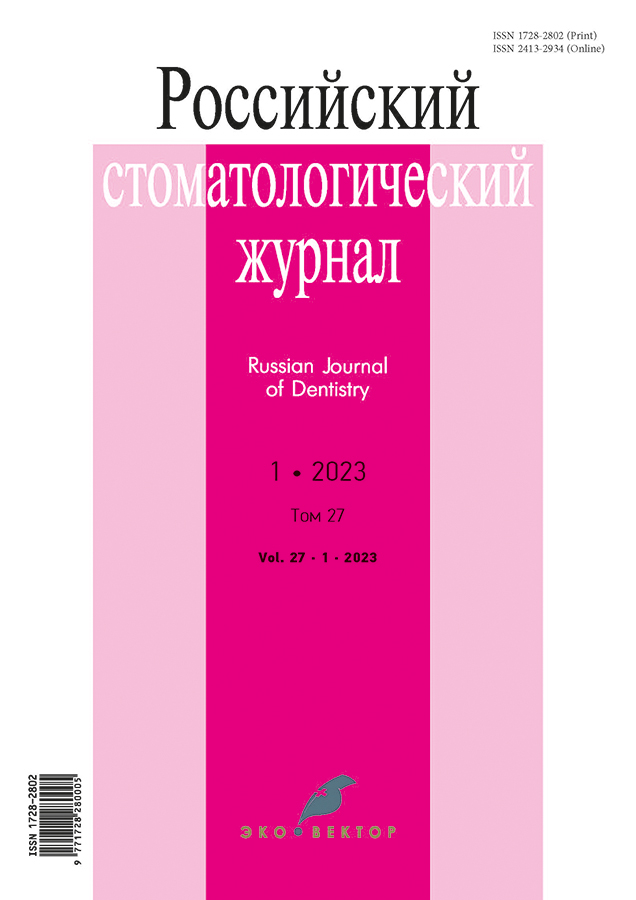Associations between dietary factors and caries among 12-year-old children in Arkhangelsk region
- Authors: Gorbatova M.A.1, Pochinkova P.A.1, Simakova A.A.1, Utkina E.I.1, Grjibovski A.M.1,2,3
-
Affiliations:
- Northern State Medical University
- Northern (Arctic) Federal University
- North-Eastern Federal University
- Issue: Vol 27, No 1 (2023)
- Pages: 41-50
- Section: Clinical Investigations
- Submitted: 02.02.2023
- Accepted: 28.02.2023
- Published: 19.06.2023
- URL: https://rjdentistry.com/1728-2802/article/view/181610
- DOI: https://doi.org/10.17816/dent181610
- ID: 181610
Cite item
Abstract
BACKGROUND: Despite the decrease in the prevalence and experience of dental caries in 12-year-old children in the Arctic zone of the Russian Federation, the quality of life associated with dental health remains low. Consumption of sweet foods has been reported to be associated with a low quality of life. However, associations between nutritional factors and dental caries remain poorly studied in Russia, particularly in the Arctic using the World Health Organization (WHO) criteria.
AIM: To study associations between nutritional risk factors and the prevalence and experience of dental caries among 12-year-old children in Arkhangelsk region using WHO criteria.
MATERIALS AND METHODS: In total, 1162 children aged 12 years in seven urban and five rural settings of Arkhangelsk region participated in a cross-sectional study using the WHO methodology. Bivariate associations between the frequency of consumption of the studied foods and caries were analyzed using Pearson’s chi-squared tests. Associations between the average values of the DMFT index and its components across frequency categories of nutritional factors were assessed by a multivariable Poisson regression.
RESULTS: Adolescents drinking soft drinks once a day or more often had significantly more filled teeth than those in the reference group (p = 0.003). An inverse association was observed between the frequency of tea / coffee / milk consumption and mean DMFT (p = 0.041), which was largely attributed to the differences in the number of filled teeth (p = 0.009). The number of filled teeth among those who consumed tea / coffee / milk at least once a day was 8% lower than in the reference group.
CONCLUSION: Among adolescents, significant associations were observed between caries experience and consumption of soft drinks and tea / coffee / milk with sugar. Measures aimed at the reduction of consumption of these items should be included in caries prevention programs.
Keywords
Full Text
About the authors
Maria A. Gorbatova
Northern State Medical University
Author for correspondence.
Email: marigora@mail.ru
ORCID iD: 0000-0002-6363-9595
SPIN-code: 7732-0755
MD, Cand. Sci. (Med.), Assistant Professor, Master of Public Health
Russian Federation, 51 Troitskiy ave., 163061 ArkhangelskPolina A. Pochinkova
Northern State Medical University
Email: polina-pochinkova@yandex.ru
ORCID iD: 0000-0002-4702-403X
SPIN-code: 3394-5945
assistant of the Department of Pediatric Dentistry
Russian Federation, 51 Troitskiy ave., 163061 ArkhangelskAnna A. Simakova
Northern State Medical University
Email: doctororto@yandex.ru
ORCID iD: 0000-0001-8883-9254
SPIN-code: 2971-2925
assistant of the Department of Pediatric Dentistry
Russian Federation, 51 Troitskiy ave., 163061 ArkhangelskElena I. Utkina
Northern State Medical University
Email: znaika.85@mail.ru
ORCID iD: 0000-0001-7277-576X
SPIN-code: 5771-0010
assistant Department of Pediatric Dentistry
Russian Federation, 51 Troitskiy ave., 163061 ArkhangelskAndrej M. Grjibovski
Northern State Medical University; Northern (Arctic) Federal University; North-Eastern Federal University
Email: a.grjibovski@yandex.ru
ORCID iD: 0000-0002-5464-0498
SPIN-code: 5118-0081
MD, Dr. Sci. (Med.), Professor
Russian Federation, 51 Troitskiy ave., 163061 Arkhangelsk; 17, emb. Northern Dvina, Arkhangelsk; Yakutsk, st. Kulakovsky, 48References
- Gorbatova MA, Matveeva IV, Degteva GN, Gorbatova LN, Grjibovski AM. Dental Caries Prevalence and Experience among 10–14 Years Old Children in the Nenets Autonomous Area (Arctic Russia) in Relation to Mineral Composition of Drinking Water and Socio-Demographic Factors. Human Ecology. 2019;(12):4–13. (In Russ). doi: 10.33396/1728-0869-2019-12-4-13
- Vorobyeva NA, Kunavina KA, Golubovich AV. Vorobyeva AI. Oral Health of the Indigenous People of Vaigach Island, Arctic Russia. Human Ecology. 2021;(4):25–29. (In Russ). doi: 10.33396/1728-0869-2021-4-25-2
- Popov VA, Vyborova PS, Gordienko AA, et al. Oral Health-Related Quality of Life among Students of the Medical University in the Russian Arctic. Human Ecology. 2020;(6):46–57. (In Russ). doi: 0.33396/1728-0869-2020-6-46-57
- Shepeleva OA, Novikova YuA, Degteva GN. Food Safety in Arctic and Subarctic Territories of the Russian European North. Human Ecology. 2019;(10):24–32. (In Russ). doi: 10.33396/1728-0869-2019-10-24-32
- Brownbill AL, Miller CL, Braunack-Mayer AJ. The marketing of sugar-sweetened beverages to young people on Facebook. Aust N Z J Public Health. 2018;42(4):354–360. doi: 10.1111/1753-6405.12801
- Lin PY, Lee YC, Hsu LY, Chang HJ, Chi LY. Association between sugary drinks consumption and dental caries incidence among Taiwanese schoolchildren with mixed dentition. Community Dent Oral Epidemiol. 2022;50(5):384–390. doi: 10.1111/cdoe.12683
- Chi DL, Scott JM. Added sugar and dental caries in children: a scientific update and future steps. Dent Clin N Am. 2019;(63):17–33.doi: 10.1016/j.cden.2018.08.003
- Kuzmina I, Ekstrand KR, Qvist V, Demuria L, Bakhshandeh A. Dental Caries in 7–17-Year-Old Children in Moscow: A Clinical and a Questionnaire Study. Oral Health Prev Dent. 2020;18(1):221–227. doi: 10.3290/j.ohpd.a43358
- Gorbatova MA, Grjibovski AM, Gorbatova LN, Zinchenko GA, Vladimirova AS. Alimentary risk factors for dental health and dental caries in 15-year-olds in the Arkhangelsk region. Clinical dentistry. 2019;1(89):4–10. (In Russ). doi: 10.37988/1811-153X_2019_1_4
- Oral health surveys: basic methods. 5th ed. Мoscow: MGMSU; 2013. 135 p. (In Russ).
- Kumar M, Prakash S, Lorenzo JM, et al. Apitherapy and Periodontal Disease: Insights into In Vitro, In Vivo, and Clinical Studies. Antioxidants. 2022;11(5):823. doi: 10.3390/antiox11050823
- Chowdhury CR, Shahnawaz K, Kumari PD, et al. Highly acidic pH values of carbonated sweet drinks, fruit juices, mineral waters and unregulated fluoride levels in oral care products and drinks in India: a public health concern. Perspect Public Health. 2019;139(4):186–194. doi: 10.1177/1757913918787218
- Khomenko LA, Sorochenko GV, Ostapko EI, et al. Experimental justification of mineralization processes’ control for permanent teeth’ enamel. Sovremennaya stomatologiya. 2020;1(78):48–53 (In Russ).
- Satou R, Oka S, Sugihara N. Risk assessment of fluoride daily intake from preference beverage. J Dent Sci. 2021;16(1):220–228. doi: 10.1016/j.jds.2020.05.023
- Collard KM, McCormick DP. A Nutritional Comparison of Cow’s Milk and Alternative Milk Products. Acad Pediatr. 2021;21(6):1067–1069. doi: 10.1016/j.acap.2020.12.007
- Lee JH. Physicochemical and Sensory Characteristics of Sponge Cakes with Rubus coreanus Powder. Prev Nutr Food Sci. 2015;20(3):204–209. doi: 10.3746/pnf.2015.20.3.204.
Supplementary files








